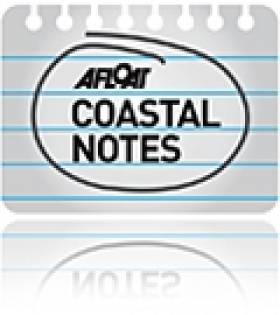Displaying items by tag: Afloat Project
‘Afloat’ Project Launches Vessels with Messages of Positivity
#AfloatProject – As previously reported, the 'Afloat' project of Dalkey-based visual artist, Roisin Cunningham, took place on Sunday where 50 bottle jars containing messages about the recession made contact in the waters of Dublin Bay, writes Jehan Ashmore.
Since then the first jar (No.22) has been found washed ashore this morning by a woman while walking on the beach at Sutton. The jar had drifted from the location of the bottle launch in the seas off The Muglins near Dalkey Island in the south of the bay. For a photo, click the link to Roisin's 'Afloat' facebook page.
The inspiration for the Afloat project had originated several years ago and is based on the main theme of communication between people and how this can be achieved. What appealed to the artist is the idea of using ordinary people's messages, often because their ideas have no platform.
As the ideas gathered, she was surprised and encouraged at how when asked to send a personal message to a stranger, people engaged in such a positive way with inspirational quotes or greetings.
The messages in the jars not only reflected the state of the nation in which in recent years we seemed to have, as an Island people, had many ideas and criteria forced on us. This is where Roisin wanted to gauge what was the general mood among the people.
In addition the jars contained a paper boat and a numbered piece taken from a painting of the Muglins painted by the artist.
The rocky outcrop of The Muglins and its lighthouse is where strong currents converge and which can make for notoriously unpredictable conditions.
Despite the swells at high-tide and under an overcast sky, Roisin was rowed out from Coliemore Harbour by the Dalkey Rowing Club's Ladies junior team, crewed by Nadine Cunningham, Sinead McCullogh, Claire Cunningham and Mary-Grace Power. They clearly displayed their rowing skills coupled by the cox of the day Pat Dalton.
So where have the natural elements taken the other jars as they bob and drift about the Irish Sea and who knows to where else?...
‘Afloat’ Awaits Time & Tides to Launch Bottles of Messages & More!
#AfloatProject – As previously reported, the 'Afloat' project headed by Dalkey based visual artist, Roisin Cunningham who was to launch bottles off The Muglins in Dublin Bay last weekend was cancelled at short notice, writes Jehan Ashmore.
Not deterred, Roisin is to re-schedule the launch date for either day of the weekend 5-6 October. Supporting the launch will come from the Dalkey Rowing Club's Junior Ladies team, who are to row out the East coast club's 'skiff' from Coliemore Harbour to The Muglins off Dalkey Island. From there all 50 bottles will be launched into the Irish Sea.
The overriding theme of 'Afloat' is to reflect on the state of the nation since the financial collapse and asks individuals to probe into how they feel themselves. In addition, the need to question our identity on several levels, as well as a collective expression of society.
Locals and visitors alike were invited over the summer to contribute ideas, quotes, or messages and place them in the bottles which will also include a piece of artwork and a paper boat.
Weather permitting, the location of the small rocky outcrop of The Muglins with its lighthouse was chosen for the bottle launch because of the strong currents that converge in this southern area of Dublin Bay.
A Nation Adrift Awaits ‘Afloat’ Launching of Ideas, Quotes & Messages
#AfloatProject – Dalkey based visual artist Roisin Cunningham is to launch her 'Afloat' project this weekend off The Muglins that neighbours Dalkey Island in south Dublin Bay, writes Jehan Ashmore.
Weather permitting, the location of the small rocky outcrop with its lighthouse was chosen for launching 50 bottles because of the strong currents meeting in this area of the bay.
Locals and visitors alike were invited over the summer to contribute ideas, quotes, or messages and place them in the bottles which will also include a piece of artwork and a paper boat.
The overriding theme of 'Afloat' was to reflect on the state of the nation since the financial collapse and asks individuals to probe into how they feel themselves. In addition, the need to question our identity on several levels, as well as a collective expression of society.
Roisin who is artist in residence at Dalkey Rowing Club, said of the project "is about the proliferation of ideas that can move without being guided or controlled".
It is a search for a truth, as opposed to, the truth and Roisin sees that art has a central task in connecting to human relations and its conditions.
Our culture can dis-joint and can dis-connect us from our lives and we can feel individual and alone. In essence we tend to forget we are a collective and we share many of the same feelings and desires.
The artist had put up quotes and ideas from philosophers, theorists and even Groucho Marx and the central idea is not just about art and artists.
It is about humans and how we live or how should we live and with the purpose of the 'Afloat' project is also to inspire positivity and room for fun!
Now that the project has gathered a diverse amount of messages from Facebook interactions and from people the artist has encountered directly, the time has come to launch them out to sea.
Supporting Roisin in the launch comes from the Dalkey Rowing Club, where the East Coast club's rowing skiff's Junior Ladies team, are to row out the boat from Coliemore Harbour to The Muglins.
From there the vessels on board will be launched overboard. All these bottles bobbing about the water face an unchartered course and equally an unknown outcome awaits... like life itself!

























